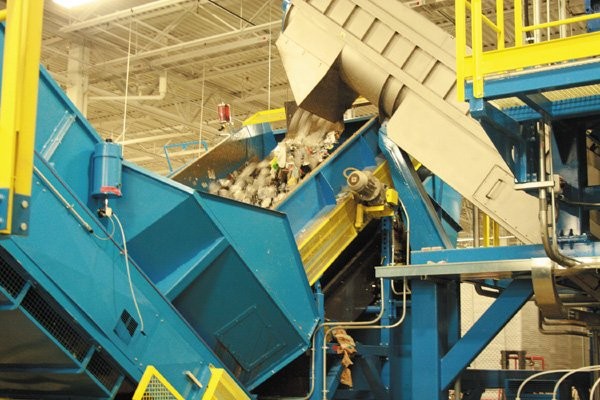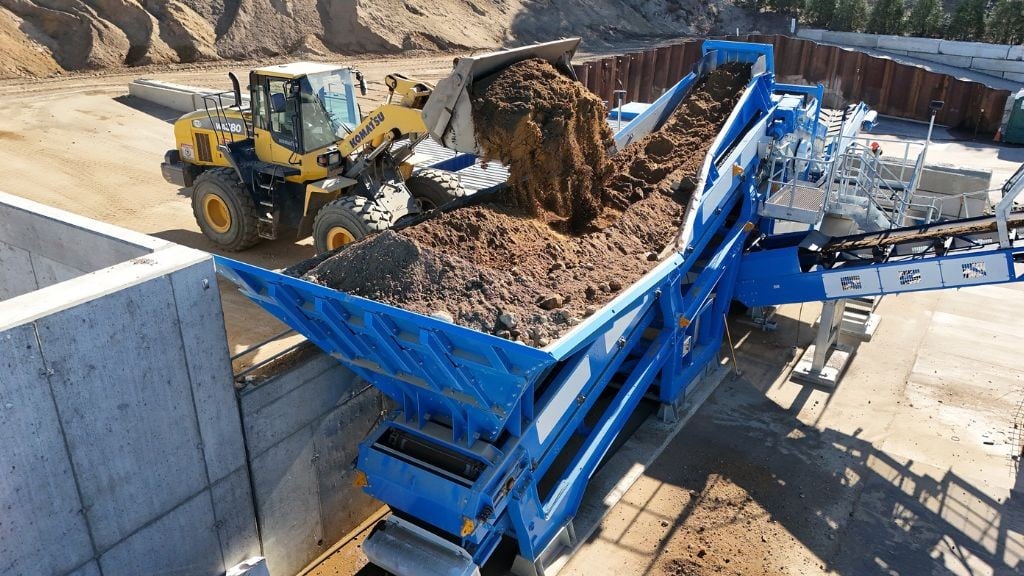Rising to the next level of water bottle recycling
Vertically integrated bottled water company first to manufacture own resin

Ice River Springs, based out of Feversham, Ontario, is a leading North American bottled water company with manufacturing plants in eight locations throughout Canada and the United States. Since October, 2010, the company has been successfully operating a new PET recycling plant, where they produce their own resin and a 100 percent recycled PET (r-PET)water bottle.
The company says their new facility is the first food-grade r-PET manufacturing operation in Canada, and that it will effectively diversify their market through the in-house manufacturing of resin for beverage production, and through sales of food-grade r-PET resin to other food and beverage companies for packaging.
“Our goal is to eliminate our dependence upon foreign virgin PET resin by self-manufacturing recycled resin from baled post consumer plastic purchased from municipal recycling centres,” states Jamie Gott, president and co-founder of Ice River Springs (IRS).
“We believe this to be a great step in our sustainability program and that it provides our consumers with an environmentally friendly option in their bottled water,” says Gott.
IRS is the first bottled water company in North America to manufacture its own resin, and at the end of June, the company was awarded the 2011 Plastics Stewardship Award from the Canadian Plastics Industry Association.
The consequences of innovation
IRS says establishing a new recycling plant of this capacity involved securing an industrial building in Shelburne, Ontario, as well as the purchase of specialized plastics processing equipment, including cleaning and purifying equipment, supplied by AMUT North America and Starlinger respectively.
According to Anthony Georges, AMUT North America president; “Ice River’s new equipment is specifically designed to clean Blue Box materials, and purify and convert plastic back into a food-grade product that can be used in all beverage and food applications which currently use virgin PET.
“Being a person who grew up in Ontario and has been involved in the environmental movement for decades, and plastics recycling for years, we are still very extremely excited about being selected as a key technological and machinery partner for this project,” says Georges.
In addition to bottling water, IRS exports pre-forms (test-tube like vials which are subsequently blown into bottles) to a major North American soft drink manufacturer in the U.S. The company says that by converting these pre-forms to r-PET, they will substantially increase sales and market share for these exports, and that their long term plan includes over 60 new full time employees. Ice Rivers’ goal is to produce enough food-grade r-PET to sustain their own needs as well as other customers that require high quality, clean r-PET materials. This will result in a plastic water bottle that is made of 100 percent r-PET, with the lowest weight of plastic required, the lightest cap, a small label, a tray made out of recycled material, and a biodegradable shrink film.
“It is a green alternative for consumers and an environmental breakthrough leading to a substantive reduction in the carbon footprint of packaging in this important consumer products sector,” says Gott.
Since 2000, he points out, Ice River Springs has decreased the amount of plastic in their bottle by approximately 40 percent, and in their caps by 300 percent. IRS also says it leads the beverage industry with one of the lightest weight 500 ml bottles in North America. Plus, the company has reduced its carbon footprint through the use of tri-axle trailers, high-efficiency lighting, geothermal chilling, high- and low-pressure air recovery, and the use of alternative energy.
The company’s new building in Shelburne is also critical to their reduced carbon footprint as it is located on a shipping lane connected to the Ice River Springs location in Feversham. Because of this location, raw materials can be back-hauled on trucks that would normally come back empty.
Overall, Ice River says this project is driven by a business and environmental ethos that seeks to reduce the carbon footprint for the company by closing the loop for plastics, reducing the demand for oil and re-processing post-consumer PET containers. This is a product that has traditionally been either shipped overseas or used in North America for single-use products like clothing, furniture or automotive applications. With their new facility, the recycled food-grade PET can produce over 20 successful generations of water bottles, and it allows Ice River Springs to be the first major water bottler in North America to use a water bottle made of fully recycled plastic. Plus, the bottles are approved by both Health Canada and the U.S. FDA.
And there are additional environmental advantages to this recycling project. Ice River Springs will no longer need to purchase virgin PET resin, which contributes to reducing the overall demand for oil. Secondly, the recycling process uses much less energy than producing virgin PET from fossil fuels. In addition, since most virgin plastic resins currently come from Asia, it will reduce transportation requirements and fossil fuel emissions.
Consequently, the company says, many Ontario recyclers will no longer need to sell their baled PET bottles to Asia, further reducing transportation emissions. Finally, purchases of PET baled plastic on this scale in Ontario will provide a stable demand for baled post-consumer plastic, stabilizing prices, making recycling centres more economically feasible, helping to promote recycling, and keeping plastic bottles out of landfills.
The technology
“We evaluated several manufacturers of our technology for both the sorting and cleaning of the post-consumer PET bottles as well as the purification of the clean r-PET materials,” says Gott.
“The choice for the washing equipment was AMUT; their technology has proved to be extremely cost effective, and utilizes a minimum amount of water, chemicals and energy in the cleaning process.
“For the purification process we selected Starlinger. Their SSP (Solid State Poly-condensation) technology, for the purification of flakes is excellent and demonstrates excellent attention to minimizing energy costs to convert the clean r-PET flakes from the AMUT washing line into high quality PET pellets. [These pellets] are then utilized in our injection moulding machinery to make the pre-forms for our new water bottles.”
“The combination of the Starlinger and AMUT systems will be the first of its kind in operation in North America,” continues Gott. “They have successfully teamed-up to recycle PET post-consumer bottles in France already. As such, we are very confident that our recycling plant will be a benefit to all, encouraging more recycling in North America.”
Anthony Georges explains how their system works. “Post-consumer bottles come in bales, and from there it goes into our process where we break up the bales, wash the dirty bottles and clean the exterior of the bottles. The main point in a washing plant is to eliminate the non-PET, and then you can focus on cleaning it."
“From the bale breaker, material goes to a constant feeder which controls the flow of material,” he continues. “From the feeder it passes under our magnet system to remove any ferrous metals, and from there it goes into our high-friction whole bottle wash.”
“After this, materials go to an automatic sorting system. We use two Titech machines which remove all the non-PET and sort out the coloured PET, in two passes,” says Georges.
“Our goal at this point is to get down to less than 50 parts per million of foreign material.”
“Next, the PET goes into our wet grinders which grind about 2,000 kilograms per hour of whole bottles each, including caps. Everything is then transferred in a slurry to a dewatering system. And at every washing stage, we use a closed-loop water filtration system.”
“The PET flake then goes through a high temperature friction washer, and four further washing stages, which gets the flake back to neutral.”
“Once you have a clean flake, you have to dry it and then verify it,” Georges explains. “We use technology from a few different manufacturers at this stage, including Ariostea, whose technology mixes, sorts and blends material to get it uniform. This helps us more easily find any remaining impurities. We also at this stage use metal sorters from S+S and colour sorting technology from Buhler, and then the Starlinger purification process purifies the resin using heat, vacuum technology and pelletizing.”
“This gives us a crystallized PET pellet with properties as good as, or better than virgin PET, which is what IRS is using to make their own resin. The whole process takes about 10 hours, from the arrival of a bale to clean r-PET pellets.”
“Plus, there’s no waste in the process,” says Georges. “We’re capturing everything. Aluminum yield can be as high as two or three percent, for example. The system also uses low energy, and water is filtered and recycled back through the system. For producing one kilogram of high quality, clean r-PET flake, we use only one litre of water.”
“It is a world first for a water bottle company to be totally vertically integrated,” continues Georges.
“Ice River Springs can process about 80 percent of all the bottles collected in the “blue box” programme in Ontario, or about 70 million pounds annually.” “I can not see this trend stopping,” concludes Georges, who said they have PET recycling plants operating in California for resin manufacturers, as well as a new plant set to be built in Alabama.
“It makes so much economical sense. For just pennies, you can convert trash into cash.”



